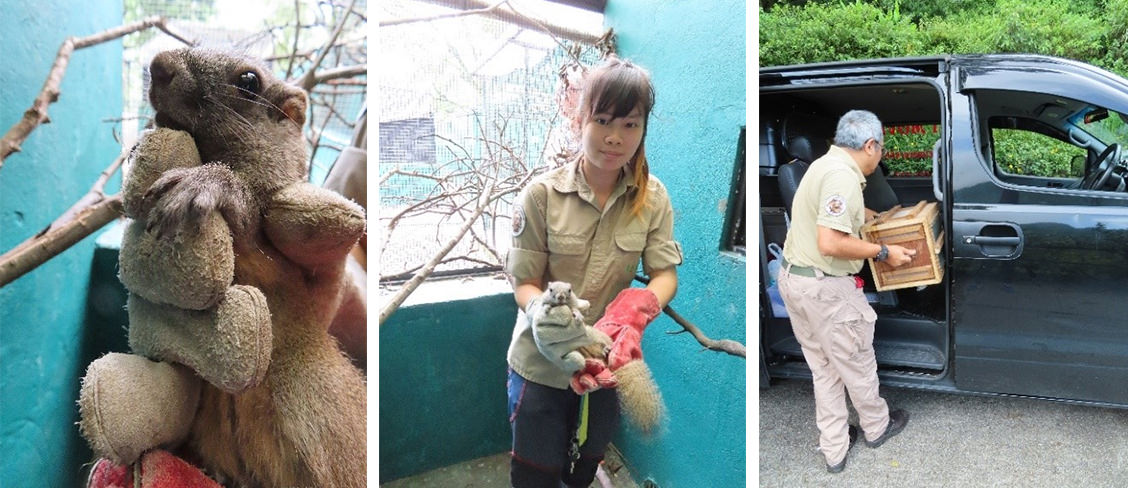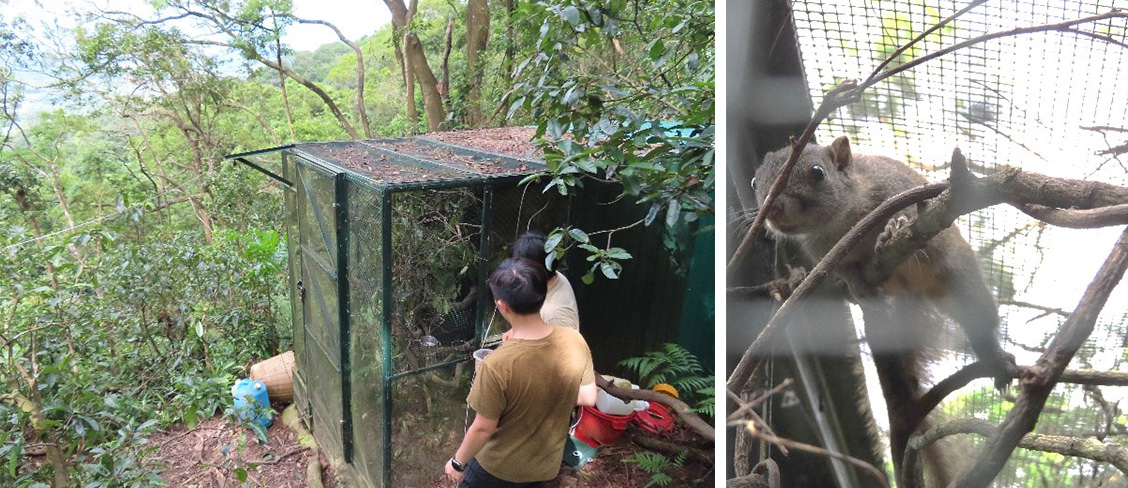The Destiny of Two Squirrels
The story of “The Country Mouse and the City Mouse” is familiar to us all. At our KFBG Wild Animal Rescue Centre (The Rescue Centre), we can tell the story of “The Seized Squirrel and the Wild Squirrel”. Both are Pallas’s Squirrels (Callosciurus erythraeus).
The ‘seized squirrel’ was part of case in which a member of the Hong Kong public was found by the Authorities to be in possession of the squirrel, which is illegal. The Authorities confiscated the squirrel and prosecuted the person who had been holding it.
The ‘wild squirrel’ is a rescued baby squirrel found in Shatin.
They were both sent to the Rescue Centre, and after appropriate captive care are now facing very different futures.
The ‘seized squirrel’ is a male Pallas’s Squirrel, which was delivered to KFBG by the AFCD in 2018. The Authorities asked us to provide temporary holding assistance and care while they undertook investigations and, eventually, the prosecution of the holder. As the squirrel’s origin was unknown, a DNA test was conducted, and it was discovered that it does not genetically match the Hong Kong wild squirrel population. Therefore, he cannot be released into the wild in Hong Kong. We had to look for a suitable long-term facility for the young male. Fortunately, Singapore Zoological Gardens agreed to provide a permanent home and incorporate the squirrel in its education programme. The same facility received a flying squirrel (Vicente) from KFBG several years ago after it was found stray in Hong Kong. Last week (23 Jul 2019), the squirrel arrived safely in Singapore. It was very active when released from its travel box. He is currently in quarantine and will soon join the educational programme.

The second story involves a wild baby squirrel delivered to KFBG from the SPCA in April this year (2019). It had not been weaned by its mother and was weak when it was found by a member of the public in Shatin. The squirrel underwent a health check and was hand fed by the KFBG Rescue Team with the objective of returning it to the wild. During captivity staff found that the squirrel was starting to become friendly to humans and agreed that if this behaviour were to continue the squirrel would not be suitable for release to the wild. A technique called “Soft Release” was therefore adopted to help develop the animal’s natural wild survival skills. It was placed in an enclosure on the woody hillside of KFBG so that it could adapt naturally with minimum human contact. Staff provide food and water regularly and will observe the behaviour of the squirrel until it is assessed as ready for release. The Rescue Team will conduct the final release assessment within this month and then hopefully the native squirrel will join the wild population present in the forest in the area of Kwun Yum Shan inside KFBG.

The Seized Squirrel and the native Wild Squirrel that arrived at the Rescue Centre have quite different backgrounds, so their outcomes are different. The rescue team often have to make these decisions for rescued animals; always considering the best options for all cases, and working closely with the Authorities to determine the appropriate outcomes.
About Pallas’s Squirrel
The Pallas’s Squirrel natural range is India, Myanmar, Vietnam, Malaysia, Thailand, Taiwan and eastern and southern China. Genetics tests suggest that the Hong Kong Pallas’s squirrels originated in Thailand and in Eastern China and are not native to Hong Kong. It is an introduced exotic species which has become naturalised in the wild. The first population may have come from abandoned or escaped pets that reproduced and established in Hong Kong to becoming part of the local wildlife. Records of the styani subspecies have been found in the New Territories (e.g. KFBG, Tai Lam, Shing Mun and Tai Po Kau), and the thai subspecies have been found on the Hong Kong Island (e.g. Tai Tam and Pok Fu Lam). It is protected by Wild Animals Protection Ordinance (Cap. 170) in Hong Kong.
Releasing exotic species may cause negative ecological consequences such as spreading diseases to native animals in nature, competing for food and territory, or threatening gene pools. Please do not release any of your pets or non-native animals. Also, do not buy wild animals as this increases demand from the wild.

